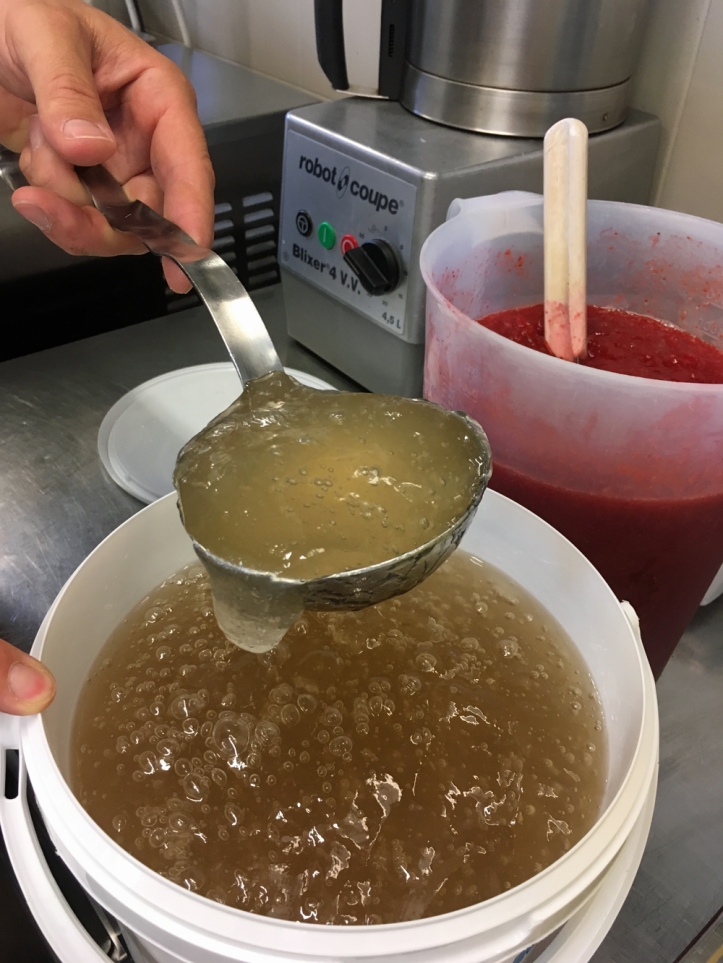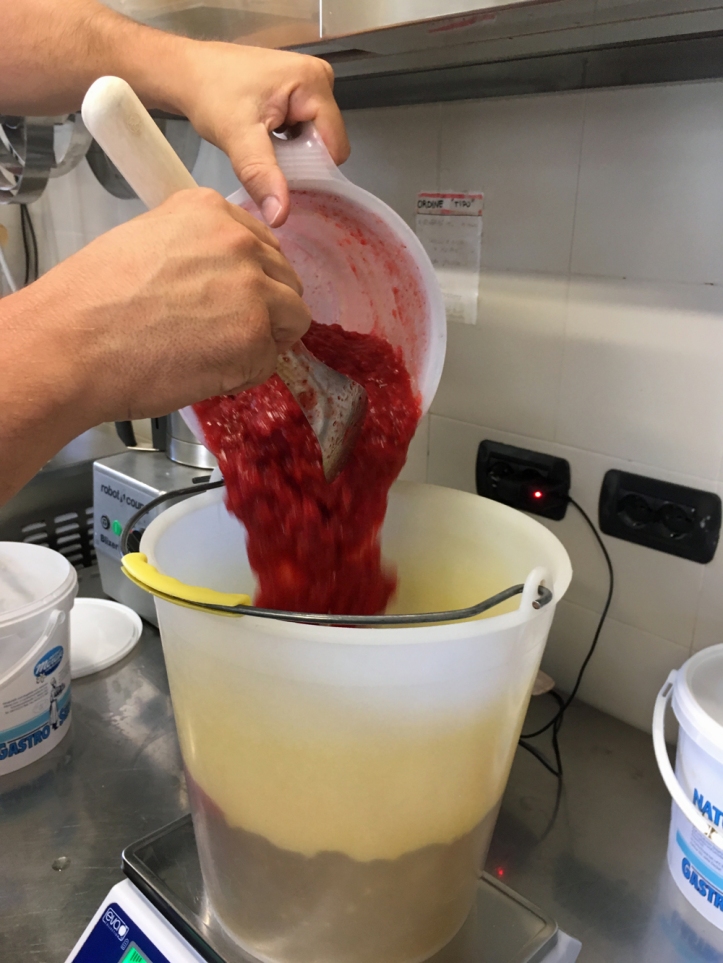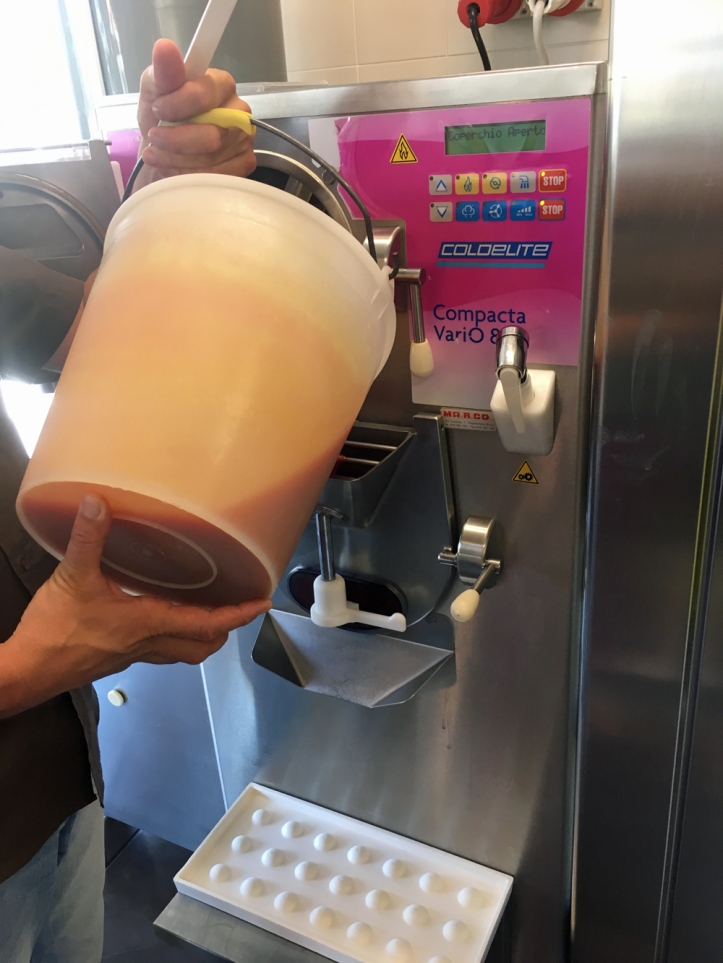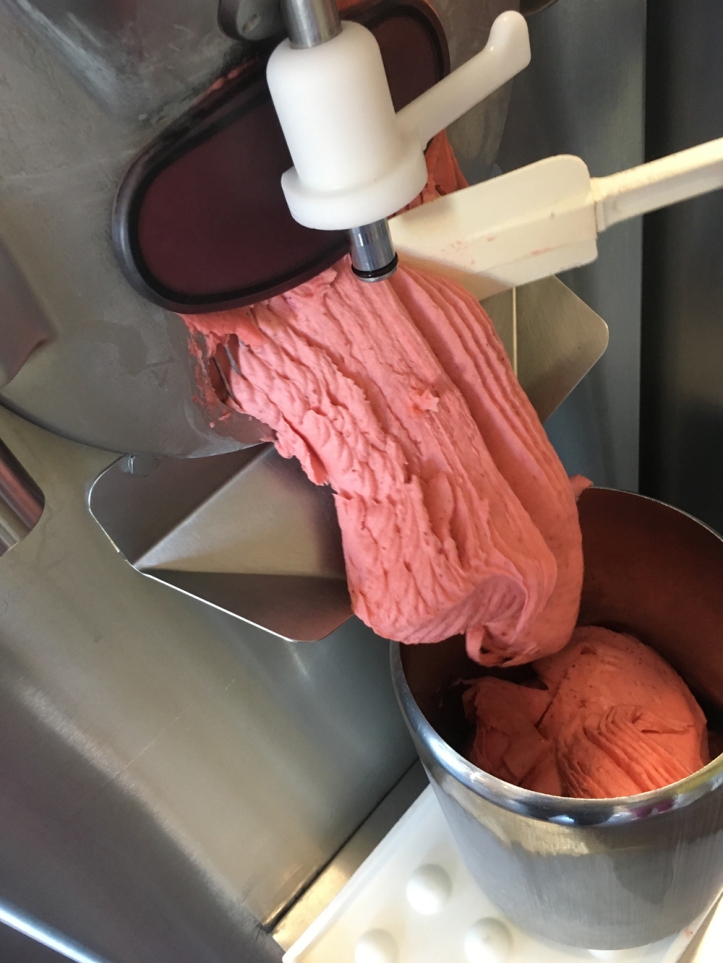Last month when we were in Garfagnana, Northern Tuscany for a wonderful holiday, I met Erica of Sapori e Saperi for a morning lesson in making gelati and sorbetti with Mirko Tognetti. We gathered around a table in Mirko’s establishment, Cremeria Opera, the third best gelateria in Italy.
Mirko is a gelatiere – an artisan – as apposed to a gelataio – someone who produces industrial (standardised) gelato or simply sells it. Within the last five years there has been a ‘Renaissance’ of artisanal gelato production and ‘guilds’ have formed to enable gelatieri a way to communicate, share tips and offer advice to one another. Gelatieri, as individual artisans, each have a speciality. Mirko’s speciality – according to Erica – is efficiency. After spending time with him, I can see that this is, indeed, true. But I would add that he is also a specialist in precision.
Not wanting to introduce spoilers here, should anyone should want to take this course in future, here are a few general things I learned.
1. Sorbetti (sorbet) contains no milk products, only fruits and a base sugar syrup.
2. Gelati contain milk products and the base (without flavour) is called fior di latte. Gelati are never made with fruit, but use nuts, chocolate, cheese (such as ricotta), caramel and similar additions as flavourings.
3. A natural stabiliser can be used, but not corn flour (as I have done on the past) for the production of sorbetti and gelati. Mirko uses a refined carob (locust bean) powder as his stabiliser as he believes it achieves the best effect without influencing the flavour. In its refined state, carob (or locust bean) powder is off-white, not a chocolately brown carob powder that is more commonly sold here in Greece.
4. Different sugars are used to create the best sweetness and ‘antifreeze’ levels. Each type of sugar has slightly different qualities and the proportions are carefully calculated.
5. The most important element in constructing a recipe is the balance of the key elements – sugars, water and other solids in the case of sorbetti, and a slightly more complex balance for gelati, between sugars, water, fat, milk solids and other solids. Each of these elements has optimal percentage parameters for the perfect balance. Flavouring ingredients each have percentages of some of these basic elements that need to be accounted for. So, quite a bit of effort is first put into understanding all of your ingredients in the constuction of your recipe. Calculator required!
Lastly, we got to the hands on section of the lesson – sorbetto della fragola.
First is the syrup, shown here already set with the stabiliser.

Second the purée of strawberries (from farms in Garfagnana) is added to the syrup and blended.

The mixture is loaded into the churner. This is a professional one that can mix up to 5kg of mixture at once and only takes about 10 minutes to chill and produce the perfect texture.

The sorbetto is extracted from the churner and put into freezer containers.

Cremeria Opera is located at 915 Viale G. Luporino, about 1km outside the fortification walls of the city of Lucca.
Erica at Sapori e Saperi designs her courses around the individual skills and interests of the student. I found the course extremely useful and it has given me direction for creating my own recipes. Erica also offers intensive courses for professionals.
If you can’t make the trip to Lucca, I can recommend Gelato Messenia by Nick Palumbo – another precise gelatiere. The book was beautifully discussed by Sandra @ Please Pass the Recipe in her search for the perfect chocolate sorbet.

Hi Debi. You and Sandra really make me think I should get my ice cream maker out. I do worry about those calories though.
LikeLiked by 1 person
Hi Glenda, I worry about calories, too. That is why I am trying to get to grips with making gelato and sorbetto. These are much lower in fat content than egg custard based ice creams. However, it isn’t easy getting the balance of ingredients just right.
LikeLike
What a great class!
LikeLike
It was a great class!
LikeLike
Now this one class I wouldn’t mind failing — again and again. “Do I really have to take it again? Dash the luck!” Love the color of that gelato that you made, Debi. You can learn from a gelato’s color.
LikeLike
Loved the lesson and the taste testing afterwards. However, I am still struggling on my own to get things just right. Sourcing specific ingredients (like maltodextrin) is tricky. Also, temperature and timing for the making of the sugar syrup mixture is difficult to judge sometime. Last batch of gelato I made was with unrefined carob powder and I cooked it too long, so the end product tasted carob-y AND was a bit too gelatinous. So taste and texture a bit off! Lessons learned and more trials to come when I finally get my hands on a better stabaliser and that maltodextrin.
LikeLiked by 1 person
What a great class. I was wondering what a sorbetti was!
LikeLike
Still learning, but having had the class really helped me see where I should be heading. Am very very keen to start producing sorbetti. Lots of fruit purée stored up in the freezer!
LikeLiked by 1 person
Nice to learn new skills in hands on classes, seems to stick better. Time to dust off both the Messina book and the ice cream churn. Thanks for the shout out Debi 😀
LikeLiked by 1 person
Hands on really did help as did the Messina book once I was back home. Will continue with my gelato/sorbetto adventures. Still haven’t got it just right. Once I do, I intend to try that chocolate sorbetto.
LikeLiked by 1 person
[…] book, Gelato Messina, and uses skills I learned last September in Lucca, Italy (see my post, Gelato Lessons). It is surprising […]
LikeLike
[…] (refined from the carob bean) was the stabiliser recommended by my instructor in Lucca during my gelato/sorbetto lesson last year. It, too, was slightly more dense than xanthan gum, a bit darker beige and also had a […]
LikeLike